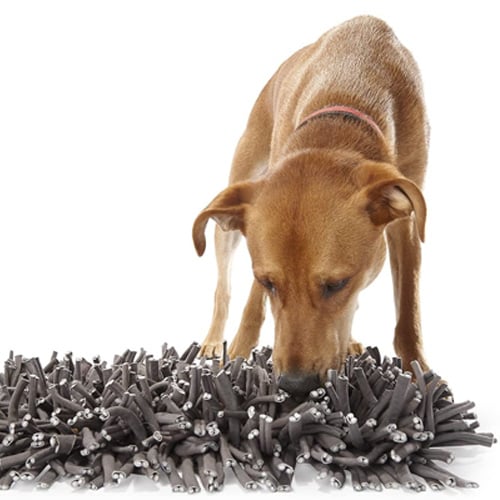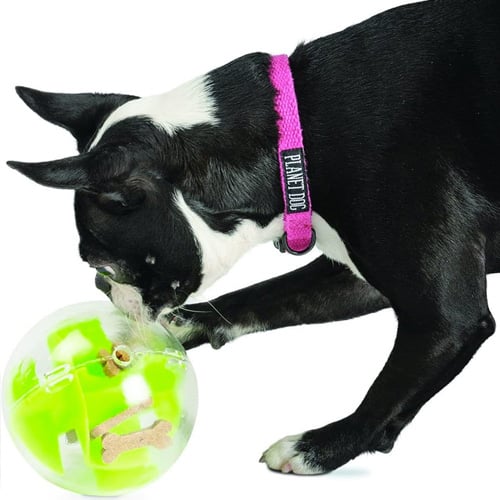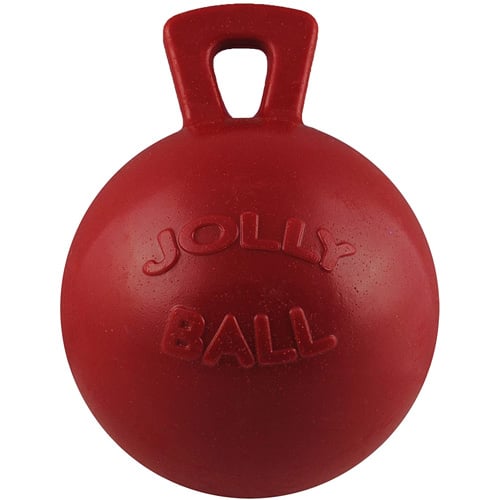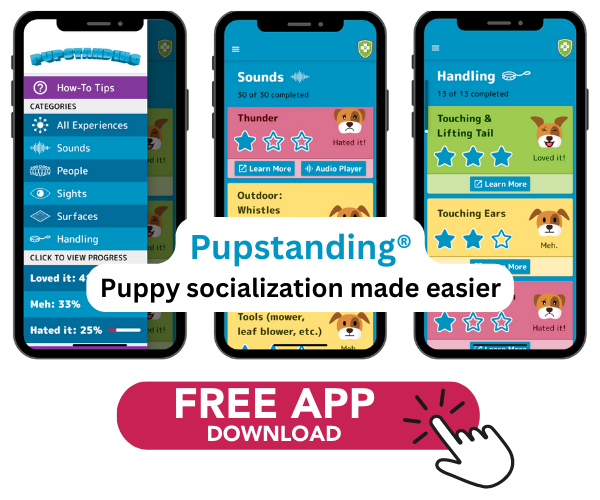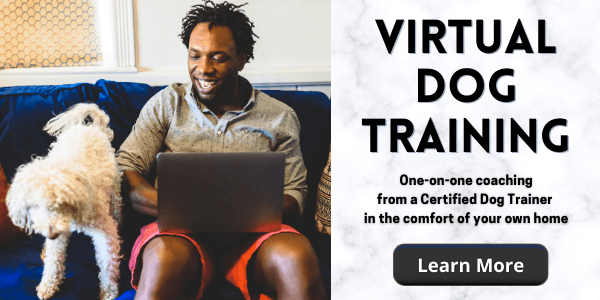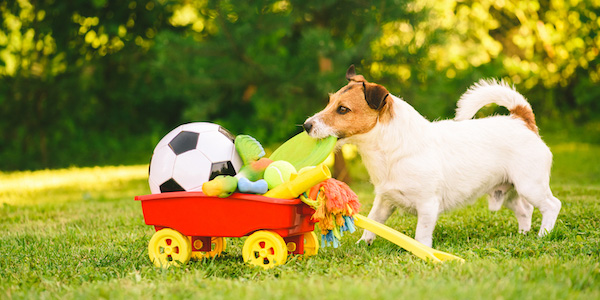 Providing enrichment for your dog is one of the most important things you can do for your dog, and it's easy to incorporate into your daily routines.
Providing enrichment for your dog is one of the most important things you can do for your dog, and it's easy to incorporate into your daily routines.
Dogs are natural foragers, needing to put their brains to work in finding food. Providing them with enrichment means we're satisfying not only this instinct to forage, but also activating all of their amazing canine senses.
But enrichment isn't just about food!
Just like you, your dog needs a variety of activities to spice up their life and keep them happy and healthy. Giving them enrichment means you are giving your dog appropriate outlets for their doggie instincts.
By meeting your dog's enrichment needs, you'll reduce unwanted behaviors like destructive chewing or counter surfing.
Enrichment helps to prevent boredom and can help with dog behavior problems, such as anxiety. Increasing enrichment is one of the first things I recommend to my clients, no matter the type of behavior problem.
It does wonders to improve quality of life and mitigate many training struggles.
Enriching your dog's life is simpler than you might think, and it doesn’t require a large budget or huge time commitment. We'll look at different DIY ideas, enrichment toys, and non-food enrichment activities you can do with your dog.
There are many ways to enhance your home environment and involve the whole family in fun activities that have a big payoff. (We haven't forgotten about our feline friends either — click here for enrichment ideas for your cat.)
Table of Contents
What Is Dog Enrichment?
Enrichment is providing animals with needed environmental stimuli that satisfy their instincts, which promotes physical, psychological, and emotional well-being. For our dogs, enrichment provides an outlet for instincts such as chewing, digging, hunting, herding, or scent tracking.
Dogs today often don't have a "job." Historically, each breed was created to perform very specific tasks, most of which involve a large amount of physical and mental stamina. In other words, dogs were bred to work, and we have stranded them in the unemployment line.
Without appropriate ways to use their natural gifts, dogs will often exhibit problem behaviors, boredom, or become stressed and anxious.
It's not just for our pets either! Environmental enrichment is used extensively with zoo animals to give them a way to practice instinctual behaviors and have some fun!
Watch this video showing how the Tennessee Aquarium works enrichment into the daily lives of the animals in their care:
Your Dog's Breed Matters for Enrichment
While many dogs enjoy all different types of enrichment, modifying your dog's enrichment activities for their specific breed group can go a long way in meeting their needs and burning excess energy in the most efficient way.
Your dog's historical jobs were direct results of both natural and artificial selection that changed your dog's body type and natural drives.
Take this quiz to get personalized enrichment ideas for your dog's breed or breed mix:
DIY Dog Enrichment Ideas
Take advantage of what you have around the house to make homemade dog enrichment toys. Get your creative juices flowing — making DIY toys for your dog is enrichment for you, too!
Think about things that can hold food that you might otherwise toss in the trash, such as empty cereal boxes (make sure to take out the bag – those are a huge suffocation risk), toilet paper rolls, empty egg cartons, empty cardboard boxes, packing paper, and more.
Here are some of our favorite DIY dog enrichment toys:
Food Tube Dog Puzzle
All you need for this fun game are some extra toilet paper rolls (or paper towel rolls cut to size), and a box to arrange them in. Shoe boxes work the best, but any box will do! Watch this video to see how easy it is to make:
DIY Lick Mat
You can create a lick mat for your dog from a variety of items you might already have. Spread a thin layer of peanut butter (make sure it's xylitol-free) on a cutting board and freeze it before giving it to your pup.
Silicone pot mats or trivets also make great lick mats due to their texture and can be tossed in the dishwasher for easy cleaning. Ice cube trays, silicone baking sheets, anything with a non-porous and non-abrasive surface can work.
I prefer silicone since it's so easy to clean afterward, and the material is gentler on a dog's tongue.
PRO TIP: If your dog prefers to just pick up the lick mat or wants to chew on it instead of lick it, place it in a baking pan slightly larger than the mat.
The sides of the pan make it harder for your dog to get a grip on the mat edges to lift it up. Remove the mat once they’re done licking all the good stuff off.
See an example of a DIY Lick Mat in this video:
Muffin Tin Dog Puzzle
I adore this enrichment puzzle because it's so simple to do, but it really works a dog's brain. Grab a muffin tin, tennis balls, and a few dog treats, kibble, or even a vegetable or two!
You can put these in every tin and cover it with a ball — or as your dog gets better at this puzzle with practice, only put the food in a few of the tins but cover them all with balls. It's a great way to work their sense of smell and practice problem-solving.
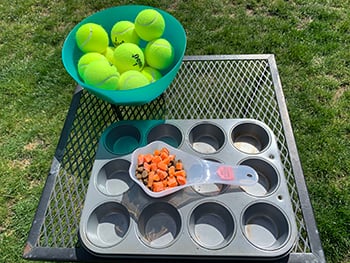
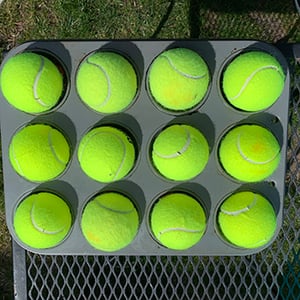
Preventive Vet pup Finnegan (a Portuguese Water Dog puppy) loved trying out this muffin tin puzzle. He even got the added socialization benefits of experiencing the feel of metal, the noise from the environment around him, and practicing problem-solving.
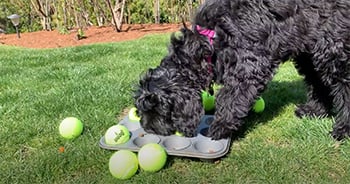
Knotted Old Clothes Dog Toy
If you have old clothes that you aren't planning on wearing anymore, you can repurpose them into dog toys — and no sewing skills are required! From T-shirts to ripped-up jeans, there are a variety of ways to cut and tie the fabric into a dog toy.
You can even add squeakers or tennis balls inside the fabric as you knot it to add some variety. This is a great project to get the kids involved and it's very eco-friendly since it helps reuse things that otherwise might go in the trash!
SAFETY TIP: When making dog toys out of old fabric, make sure to launder the item first to remove scents, then cut strips from it and create a non-clothing-item looking toy.
If your dog already has a habit of stealing your clothes to chew on, avoid these types of DIY toys.
You’ll want to practice safe management to prevent grabbing inappropriate items, practice the Leave It and Drop It cues, and provide lots of alternative outlets for their play energy.
Watch this quick video to see one technique:
Cardboard Boxes and Packing Paper
Another great option for any dog is scent games. Hiding treats in boxes and allowing your dog to do what they do best, and sniff them out. This is one of the most confidence-boosting and stress-relieving activities for dogs!
This gives you a way to put all those boxes from recent deliveries to use before recycling — make them into enrichment boxes. The different texture and sound from the packing paper is great environmental socialization for puppies.
This can be as simple as tossing some kibble and treats into a box with packing paper wadded up inside, or you can incorporate things like stuffed KONGS or one of your dog's favorite squeaky toys to find.
Here's my dog when he was a puppy, showing how easy it is to make a cardboard box and packing paper into an enrichment activity:
Rolled-Up Treat Burrito Towel
This game is super easy to set up. Grab a towel and lay it flat. Spread some treats on it, then roll it up into a little burrito for your dog to forage in. I like this game for dogs that are starting Treibball, as it helps teach them to push things with their nose.
As with snuffle mats (listed further below), remove the towel once your dog has found all the hidden treats inside it. You don’t want them to shred and ingest the towel in continued efforts to make treats magically appear again.
Watch how easy it is in this video:
Our Top Dog Enrichment Toy Picks
If you aren't feeling crafty or have time to DIY, then there are tons of dog enrichment toys to pick from that you can buy. I have a lot of different dog enrichment toys, puzzles, and games.
Here's a picture of just some of my dogs' interactive feeders and puzzles that I rotate for meals to provide enrichment. You can learn more about all these different dog puzzles and interactive feeders (and how to introduce them to your dog) here.
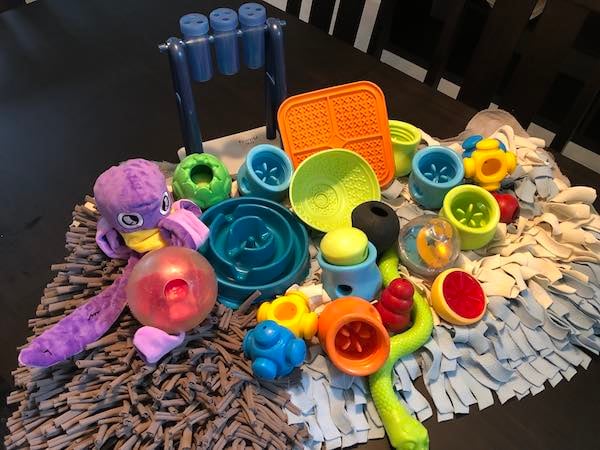
I want to share some of my favorite dog enrichment toy types with you to try out with your dog. Mixing up dog puzzles, interactive feeders, and toys is so important to keep things interesting and enticing.
Variety truly is the spice of life! Remember – it isn't enrichment if it happens every day.
I highly recommend that dogs be fed from puzzle bowls or other interactive toys rather than a regular dog bowl. That way, your dog burns energy, practices problem-solving, and doesn't gobble down their food (which could help prevent a life-threatening case of GDV/Bloat).
The Mad Scientist puzzle below is on the more difficult side and perfect for dogs that have figured out other puzzle feeders.
Preventive Vet dog Finnegan recently evaluated a similar food puzzle from Loobani. It took him about ten minutes to figure out how to get it to dispense treats, ten minutes to get all of the treats, and then he was ready for a long nap.
Snuffle Mats
Feeding dogs from snuffle mats is one of the easiest and more "hands-off" enrichment activities you can do. Scattering a dog's food means they have to put their nose to work and slows down their eating. Snuffle mats, like the PAW5 mat below, give you an easy indoor option for scatter-feeding your dog.
A great beginner enrichment activity is the Snuffle Mat. These mats are made from strips of fabric tied to a base, and food and treats are placed inside and on top of the mat. You can purchase these online, or make one yourself.
The vast majority of dogs I have met take to the Snuffle Mat right away. The act of sniffing and foraging for food is a naturally calming activity for dogs.
Safety Note: If your dog loves to shred things, supervise any snuffle mat use, as you don't want them to shred or ingest the fabric. Keep the snuffle mat stored somewhere out of reach when not in use.
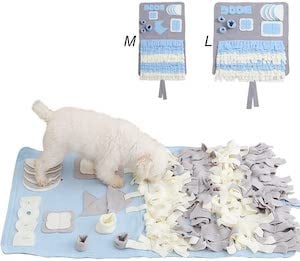
Licking Mats
These licking mats are one of my favorite summertime treats to give my dog — I smear some of her wet food or peanut butter on the mat and freeze it before giving it to her as a treat.
These licky mats come in different textures, have four different "zones" to spread different treats, and are dishwasher-safe! Repetitive licking can have a calming effect for dogs that suffer from anxiety — the release of endorphins caused by the action of licking helps them relax.
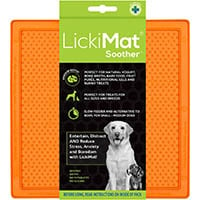
Dog Treat and Puzzle Balls
For dinnertime, I give my dog Sookie her dry food in an Orbee-Tuff Mazee ball, and it helps to slow down her eating and burn off some of her evening zoomies. It's fun to watch her figure out how to get the kibble out and push it around the house with her nose.
If I need a quick way to keep her busy while I get something done, I'll throw in a few high-value treats of varying sizes in the ball to make it harder.
Stuffed Dog Toys
I love these stuffed toy puzzles for dogs that are toy-motivated and love rooting out their "prey." This type of enrichment satisfies the instinct to dissect "prey."
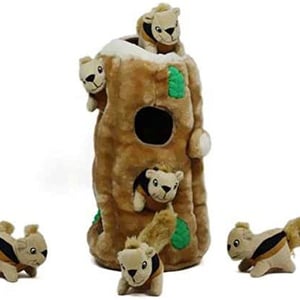 An easy option is to take a JW Holee Ball and stuff it with other small toys and treats rolled up in packing paper or fabric strips. Your dog has to figure out how to pull them out through the holes.
An easy option is to take a JW Holee Ball and stuff it with other small toys and treats rolled up in packing paper or fabric strips. Your dog has to figure out how to pull them out through the holes.
The Hide-a-Squirrel puzzle toy from Outward Hound comes in different sizes, and they also have replacement squirrels for when one inevitably goes missing.
Remember, if your dog is an inhaler or swallows small toys, these stuffed toy puzzles should be avoided to prevent digestive obstruction.
The Jolly Ball
These toys are a favorite for dog daycares, and dogs of all types (but especially herding breeds) seem to really enjoy them. It provides an appropriate outlet for dogs who love to chase and herd. Having multiple Jolly Balls can increase the difficulty level.
The Jolly Ball Original and Jolly Egg are made from tough plastic that stands up to chewing and tossing. The Mega Ball, made originally for horses, has an anti-burst design, which makes it a great choice for dogs that like to chase (but not if they like to bite down on it).
Dog Toy Safety
Whenever you're making your own puzzles and toys or using store-bought toys, make sure that they are safe for your dog and always supervise their use. No dog toy is truly indestructible.
Many toys and puzzles have small pieces that could be easily chewed off and swallowed. Supervise your dog while they are playing with their toys and throw away toys that are damaged.
For example, the Food Tube Puzzle should not be used with Brachycephalic (or "flat-faced") dogs, or any other dogs with bulging eyes, as their more prominent eyes are likely to get scratched on the tubes.
This can lead to damage to their corneas (the clear surface of their eyeball), requiring medical care. You also don't want your dog chewing up and swallowing any piece of a toy or DIY puzzle that's not meant to be eaten!
When choosing appropriate toys and enrichment activities for your dog, take into account their “chewsonality.” If your dog has a “destroyer” chewsonality, choose enrichment toys made specifically for chewers (such as the KONG Extreme).
If your dog is an inhaler, use judgment in what materials you use for enrichment toys, and take any toy away before it’s small enough to ingest. For the nibbler dogs out there, supervise any use of toys that have pieces that could be nibbled off and swallowed.
If your dog has issues with grabbing non-toy items around the home, make sure the toys you make or buy don’t resemble those items (and you’ll also want to start practicing good environmental management and training to prevent that behavior from happening).
Enrichment Games for Your Dog
Make a Scavenger Hunt for Your Dog
Hide some of your dog's favorite treats around the home and help them search them out. Kids really like getting involved with this game and picking the hiding spots.
You can do this outdoors in a securely fenced yard as well, just make sure you watch out for toxic mushrooms and remove them before setting up your dog's scavenger hunt.
I suggest using some stinky high-value treats for a scavenger hunt, as often, dogs won't work hard to find their regular dry food. Help them find each item and give lots of praise when they do!
Play Hide-and-Seek with Your Dog
Another family favorite, hide-and-seek, works your dog's nose and reinforces their come-when-called behavior. Start easy with this game so they're successful in finding you and have a big praise party when they sniff you out. Then make your hiding spots increasingly trickier as your dog gets the hang of the game.
This video shows two German Shepherds playing hide and seek with their human and is quite entertaining:
Take Your Dog on Sniffari Walks
Sniffari walks are a great decompression activity, and a perfect way to give a senior dog outdoor time without overexerting themselves. I recommend mixing in regular sniffari walks with your regular, more "regimented" daily walks.
Read more about how to do sniffari walks the right way in this article.
Watch this video to see Sookie on her sniffari:
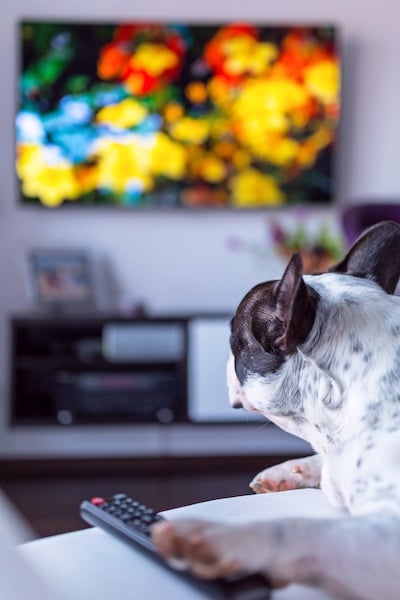 TV for Your Dog
TV for Your Dog
This is a great passive enrichment activity for when your dog is home alone or you're trying to get some chores or work done, and they need entertainment.
DogTV has on-demand and live programming curated specifically for dogs. You may notice that certain colors are more obvious on-screen, which is done intentionally to better match a dog's vision capabilities and motion sensitivity.
And there are a variety of sounds, from wildlife to soothing music played throughout.
I turn on DogTV whenever I'm headed out to run errands, so my dogs have something to watch besides squirrels out the window and have music to mask outdoor sounds that would otherwise make them bark.
Sit With Your Dog and Watch the World Go By
Find a park bench and sit and relax with your dog, letting the world pass you by. This activity is perfect for puppies in their imprint period, when exposure to a variety of things from a distance is important for socialization.
You don't need to interact with anything; just let your dog take it all in.
This is enrichment for all their senses and gives you a chance to decompress with your pup — see if you can identify how this is engaging all five of your senses too: What colors and movement do you see? What do you smell, and how does that affect what you taste? What does the bench feel like when you touch it? Do you hear birds singing or children playing?

Build an Agility Course for Your Dog
You can make an easy agility course for your pup in a hallway or go all out with a full course out in the yard. Use regular cones or even cardboard boxes to create weaves and jumps if you don't have actual agility equipment.
At the office, we set up these FitPAWS hurdles for Portuguese Water Dog Clover, and she's a big fan:
Make sure the obstacles you set up aren't overly challenging (or too high) for your dog and walk them through a few times, rewarding them for working through each obstacle. It's all about having fun!
This activity is great for building what's called "proprioception," your dog's awareness of their body in the environment and ability to balance. Watch our Preventive Vet office pups work through an easy maze we set up one afternoon in this video:
Create a Dig Area for Your Dog
Does your dog love to dig? Digging is a natural dog behavior, and providing some digging enrichment will satisfy your dog's urge to get their paws dirty. To save your garden, provide your pup with somewhere they are allowed to dig. You can do this in a variety of ways:
- Use a kiddie pool or sandpit container and fill it with kid-safe dirt or sand.
- Designate a specific corner or area of your yard that's okay to dig in. Mark it with small garden dividers to help your dog learn where it's okay to dig.
- Build a raised garden bed filled with rich, well-draining soil or a mixture of sand and compost.
- Bury some of your dog's toys, treats, or chews in their designated area. Make it easy at first, leaving the toy partially uncovered before burying it completely. (If burying treats or chews, discard those that haven’t been dug up that day — you don’t want to attract any unwelcome wildlife into your yard! Regularly wash other toys that spend time in your dog’s dig pit.)
- Explore the dig pit with your dog, get involved in helping them uncover their buried treasure, and get excited with them when they find things.
- If your dog goes to inappropriate areas and starts to dig, simply redirect them back to their special area. Then consider blocking off their access to the other areas to prevent digging in the wrong spot.
Watch this video to see how easy it is to build your dog their very own dig pit:
Blow Some Bubbles
Kids and dogs alike can get in on the fun with bubbles! Blowing bubbles can be an enriching experience because it activates different senses for your dog. They can watch and chase the bubbles as they float, then sniff and taste when they catch them.
There are even bubble options made specifically for dogs, with scents and flavors like peanut butter, cheese, steak, or bacon! Make it even more entertaining by getting a bubble blower machine.
Create a Scent Garden
If you have an outdoor space, creating a scent garden for your dog can provide amazing scent enrichment. Heavily dilute dog-safe scents, such as lavender, rosemary, or spearmint, and spritz one or two sprays onto an outdoor feature like larger rocks, tree stumps, etc.
Another option is to use dried herbs and rub them directly onto the surface to transfer the scent. Allow your dog to explore the new scents and follow their nose.
Allow the scent to dissipate over a few days, and then use a different smell the next time. Remember — dogs' noses are sensitive! Dilute scents heavily and only use a little bit at a time so their noses don't get overwhelmed.
Catnip & Other Food Toppers
Perhaps the easiest way to increase enrichment is to use different "garnishes," food toppers, or mix-ins with your dog's meals to provide novel tastes and smells. This introduces new tastes and textures for your dog.
Use different wet dog food to mix in with your dog's dry food — especially helpful when using stuffable dog puzzles to make them last longer and increase engagement with the puzzle. Add dog-safe fruits and vegetables.
Garnish your dog's puzzle feeder or bowl with a hard-boiled egg (shell included!) or a whole sardine every so often to treat your dog. Or sprinkle a little bit of catnip on your dog's food.
The possibilities are endless! Just make sure you balance out any extra taste enrichment by reducing other daily calories.
Catnip, when used in moderation, is safe for dogs and can be beneficial. Catnip is a plant that contains vitamins, minerals, flavonoids, tannins, and oils. With that said, do not give your dog catnip cat toys.
These toys are typically small and can result in choking or a potential intestinal obstruction since dogs like to dissect and swallow them.
Catnip has been found to have a sedative effect on dogs. However, this only occurs when they eat it, and a little goes a LONG way. Unfortunately, it is hard to predict its effects.
Additionally, some dogs can become hyperactive instead of sedated. Catnip has been found to help some dogs with indigestion, cramps, diarrhea, and gas. Again, only a small amount is needed.
How Much Catnip Can You Give Your Dog?
The average dose is 1/8 tsp to ½ tsp of dried catnip per kilogram of your dog's body weight (1 kilogram = 2.2 pounds). Use the calculator below to figure out how much catnip your dog should get. Always start at the lower end of the range since your dog's reaction cannot be predicted.
For example, if your dog weighs 30 pounds (13.61 kgs), divide 13.61 by 8 = 1.7 teaspoons for the low range of catnip. For the high range, divide 13.61 by 2 = 6.8 teaspoons. So, a 30 lbs dog would get between 1.7 and 6.8 teaspoons of catnip.
Enrichment for Senior Dogs
As your dog ages, their need for mental enrichment remains crucial for their well-being. In fact, it helps balance out less physical exercise if they have trouble with pain or mobility.
Mental enrichment is essential for senior dogs as it helps maintain their cognitive function, combats boredom, and prevents the decline associated with aging.
Enrichment activities keep your dog's brain active and engaged, promoting a sense of purpose and satisfaction. Enriching their minds can alleviate symptoms of anxiety and enhance their quality of life, helping them remain sharp, happy, and healthy in their senior years.
Most of the enrichment toys and activities we've mentioned so far are accessible and appropriate for senior dogs. However, your dog may need some adjustments based on their health, preferences, and energy levels.
Ideas for Senior Dog Enrichment
- Slow Walks and Sniffaris: Let your senior dog explore at their own pace. Never rush them, and let them stop and sniff as long as they want.
- Swimming: Swimming is a low-impact exercise that can be great for senior dogs. As long as your dog knows how to swim and enjoys it, this can be a great way to provide a change in activity.
- Gentle Playdates: Arrange calm meet-ups with other friendly dogs of your dog's size. This should only be done if your dog enjoys socializing with other dogs. Not all dogs do, and that's okay. Always respect your dog's preferences.
- Family Time: Including your senior dog in social activities like hanging out in the yard or movie night.
- Nose Work Games: Focus on nose work games for your senior dog, especially if they have hearing or vision loss.
- Interactive Feeders: If your dog enjoys using interactive feeders, then make sure you help them if they are struggling and getting frustrated. You may need to loosen a treat or show them how it works.
Different Types of Dog Enrichment
Enrichment for the Canine Senses (Sensory Enrichment)
There are different kinds of enrichment to consider — it's not only about the latest treat or toy. When considering ways to enrich your dog's environment, think about the five senses: smell, sight, hearing, touch, and taste.
Variety is key when it comes to enrichment for your dog. Mix it up from one day to the next.
- Use different kinds of materials when making your dog puzzles, as these smell, feel, taste, look, and sound different while your dog is tossing them around trying to get their food out. Switch out different types of toys to provide variety.
- Walking on different kinds of surfaces and letting your dog roll around in the grass or dirt gives them some excellent tactile enrichment.
- Play different sounds or types of music for your dog for sound enrichment. Hang up a wind chime every so often, or introduce the sounds of different birds or animals they don't usually hear
- Create a scent garden by spritzing diluted and dog-friendly smells on various surfaces and letting them explore.
Environmental enrichment is especially important for young puppies in their initial imprint period (between 7 to 16 weeks of age). If you have a young puppy, download our FREE Pupstanding App for an interactive socialization checklist to work through different enrichment experiences.
Cognitive Enrichment for Dogs
From puzzles to training sessions, problem-solving is also considered an enrichment activity because it expends both physical and mental energy. Cognitive enrichment can wear out a dog as much as a run in the park. Training sessions and brain games can be equated to crosswords or Sudoku puzzles for humans.
Sign up for a dog training class that goes beyond just the basic obedience behaviors, such as trick training or nose work classes. There are lots of dog sports you can get involved in as well, many of which build on a dog's natural breed tendencies.
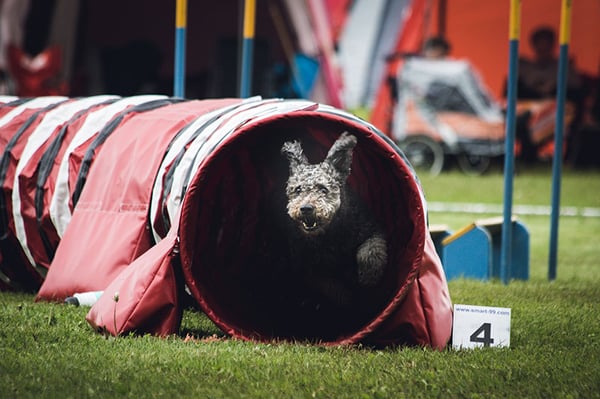
If your dog is a herding breed or mix, a sport like Treibball (Urban Herding) is a great way to work their skills. Earthdog or Barn Hunt allows terriers to dig and track rodents. From dock diving to Flyball, there's a sport for every dog and their person!
And just because a dog might not be genetically predisposed to a particular activity, it's still fun to try it out and see if they enjoy it. There have even been Basset Hounds who run agility courses!
Even if you live in an area without nearby dog sports clubs or training classes, there are online options to get you started, such as the Fenzi Dog Sport Academy.
Social Enrichment for Dogs
Beyond just environmental enrichment, dogs also need social enrichment, such as play and interaction. Dogs are incredibly social creatures, and isolation can cause them stress.
If your dog enjoys and does well playing with other dogs, consider regular playdates or trips to the dog park (Learn more about What You Should Know Before Taking Your Puppy to the Dog Park here).
Dog daycare is another great option to give your dog social interaction with other dogs. If you're not sure if your dog would like going to daycare, read our article "Will Your Dog Enjoy and Do Well in Daycare."
Age-Appropriate Enrichment
Enrichment should be tailored to each dog’s preferences, needs, and abilities. Senior dogs have different needs and physical abilities than adolescent dogs, and puppies need different things than adult dogs.
If your dog is hard of hearing or sight-impaired, adjust the enrichment to engage the senses they do still have, like smell or touch.
If they have a harder time moving around or have arthritis, choose enrichment activities that they can enjoy while staying comfortable in a small area. Consider putting down a mat to give them some traction while they work on a puzzle.
Some dogs can get frustrated with different enrichment toys or puzzles. If they are very insecure or tend to give up easily, you want to avoid any toy or activity that frustrates them or causes them stress.
Every dog is unique and has different tolerance levels for frustration. Watch the dog’s body language as they are engaging in the activity.
If they appear to be stressed or uninterested, try something easier so they can build confidence knowing that this is something that they can succeed in.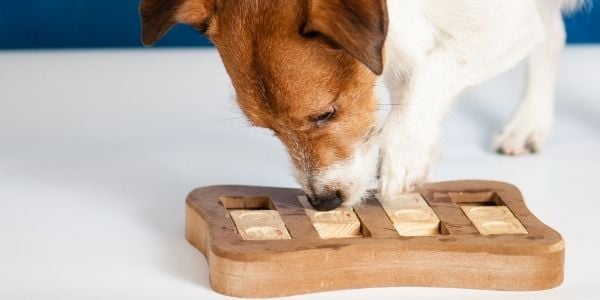
Why Is Enrichment Important for Your Dog?
- Enrichment Helps with Puppy Socialization: Enrichment toys and activities expose your puppy to a variety of sights, smells, sounds, and textures that help their brains develop. Problem-solving skills they practice while young will help them grow into a resilient adult dog.
The key to puppy enrichment is keeping everything positive and not letting them get too frustrated when solving puzzles. Start easy and slowly work your way up to harder and harder puzzle toys. - Enrichment Helps Reduce Anxiety and Stress: Shelter dogs are often given environmental enrichment to reduce stress. A recent study found that “the use of environmental enrichment methods through different types of games and toys in shelters decreased signs of depression and stereotyped behavior of kenneled dogs.”
Providing enrichment for our dogs at home can help with issues such as separation anxiety and make events such as moving or large gatherings of houseguests much less stressful. - Enrichment Prevents Boredom: Chewing, licking, sniffing, and shredding are the four most common behaviors that dogs engage in when trying to reduce stress or boredom and calm themselves. This is the reason that dogs are so often destructive when left alone.
Providing enrichment that satisfies these behaviors will help prevent unwanted behaviors (such as destructive chewing) that dogs engage in when they're looking for something to do.
Get more tips on how to use licking, chewing, and sniffing to calm down a hyper or anxious dog here. - Enrichment Provides Physical and Mental Exercise: Enrichment games and puzzles are a great way to give elderly dogs with painful conditions or physical limitations a way to get in some exercise.
The same goes for young puppies that shouldn't be engaging in strenuous activity until their growth plates have fully grown.
Dogs need exercise, but high levels of physical activity can sometimes have a negative effect on their behavior. Mental enrichment activities can help balance out physical exercise.
Dogs need to move their bodies every day, but high-intensity exercises like fetch, running, and playing with other dogs increase adrenaline levels. Your dog needs you to provide a way to bring those adrenaline levels back down to normal after strenuous activities.
All of the above benefits of enrichment mean that your dog will be better behaved and an overall happier dog. Doing different enrichment activities with your dog strengthens your bond and is quite a mood booster for both canines and humans!
What's your dog's favorite enrichment activity or toy? Share in the comments below!



